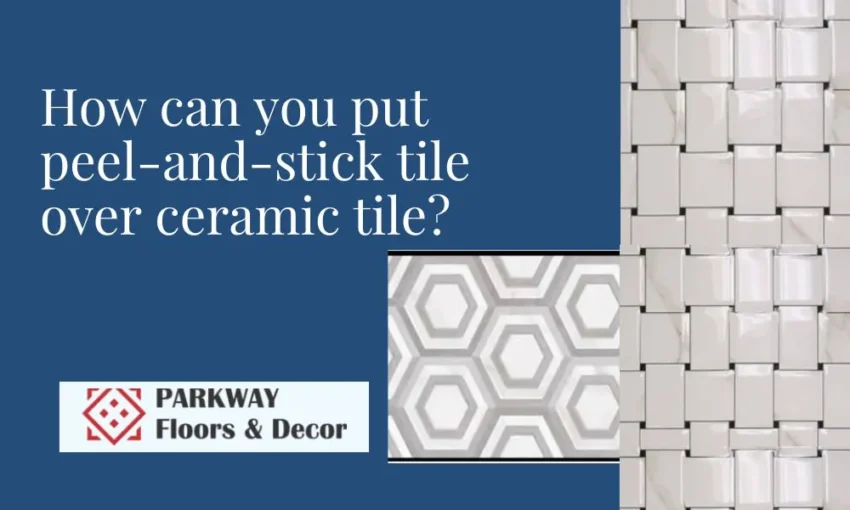All you need for these amazing little ceramic tiles is a straight edge, a level, and a basic utility knife; neither a tile splitter nor a contractor is needed. Best of all, since they can be laid over your current tiling, you won’t have to use a demo hammer while donning noise-cancelling headphones.
Is it possible to tile over tile?
In response to your urgent query, the answer is, yes. You can use peel-and-stick tile on painted walls and linoleum in addition to tiling over actual tile. Pick your peel-and-stick brand wisely, though, since some will stick to every nook and cranny in the tile surface. Check to see whether the manufacturer suggests speckling any surface flaws and grout lines.
For some, that would be a deal breaker. If you want to avoid filling in the grout lines, be sure your new tile will fit over your old tile smoothly by carefully inspecting it and reading reviews. Select detachable tiles so you can try them out beforehand. Use a blow dryer on it until the glue releases if you don’t like the way it looks.
Examine a range of sources
The more readily available, frequently removable vinyl and gel varieties, such as peel-and-stick tile, may come to mind when you hear the term peel-and-stick tile. However, there are a plethora of alternative materials available for peel-and-stick, including glass, PVC, metal, and even stone. Many resemble handcrafted glass tiles or ceramic tiles.
When they cannot be removed
Not every self-adhesive tile can be removed, and when it can’t, it usually can’t be. Thus, you should apply them carefully and according to your level. The tiled surface may be harmed if the permanent type is forced upward.
A few are resistant to water
Use extreme caution when utilizing peel-and-stick tile in areas where moisture may be present, as most of them are not highly water-resistant. Before putting the self-adhesive ceramic tiles down, you can prepare the surface with a sealer.
Think about the price
The cost of installing self-adhesive floor tiles ranges from $XX to $X per square foot. If you lay ceramic tile yourself, the cost per square foot is $5XX; if you employ a contractor, the cost is $XX.
Balance the pros and cons.
In locations where mildew or spills are more likely, it could be wise to invest in genuine tile; for low-maintenance areas, like walls, peel-and-stick flooring is a good option. Though some sources claim that when done effectively, non-wearing tiles boost the value of your home, keep in mind that if you plan to sell your house soon, this may not be the greatest choice.
This is the general procedure for attaching self-adhesive ceramic tiles to surfaces in your home; each manufacturer has their guidelines.
-
Get Your Surface and Tile Ready
Give your tiles 48 hours to get used to the space in which they will be installed. Use a degreaser to thoroughly clean the surface you want to tile. Before you begin, you can take off any outlet covers.
-
Take a seat in the lower corner.
Start the tile-laying process from the bottom corner edge, making sure to use a level to prevent the tiles from slanting gradually as you work. The tile should be carefully pressed to the surface after the adhesive film has been removed from its back. To even out the tile’s surface and eliminate any air bubbles, use a credit card.
-
Tiles Are Easy to Set and Clean
To trim tiles to fit in narrow spaces, use a utility knife and a straightedge. Avoid using strong chemical cleansers on newly installed ceramic tiles as this could harm the bonding agents. Use a solution of dish liquid and water, or dish liquid, white vinegar, and water, instead.
Try This with Little Nooks
Start small when experimenting with peel-and-stick; consider tiling the walls of your mudroom or the interior of a coat closet. You can easily incorporate pattern and colour into your home library by simply sticking a peel-and-stick tile to the back of your bookshelves.
Proceed to a handmade backsplash
Peel and stick Renters can update their outdated apartment kitchen tiles with backsplash tiles. They’re also a great method for homeowners to try out more vibrant mosaics or bolder designs without having to commit to a major home remodelling project.
To hide the current eyesore in your kitchen, you can go traditional and choose subway tiles for your peel-and-stick backsplash. Choose geometric tiles, such as hexagons or chevrons, to give your kitchen a mid-century air, or try something a little different, like fresh pink subway tiles. For a pleasant touch, you can add a single colourful tile here and there to an otherwise white backsplash.
Locations For Peel-And-Stick Tiles Flooring Installation:
Bathroom Floors: Consider terrazzo tile for a playful look in a stark white bathroom.
Laundry Room: Install Moroccan peel-and-stick tile on your laundry room’s flooring to add some flair to menial tasks. New tiles in the foyer provide a striking splash of colour that anchors the entire house.
Fireplace: Replace the worn-out brick or ceramic tiles surrounding the base of your fireplace with peel-and-stick tile to update the look of your surroundings. Older homes look so good with designs that have a vintage feel.
Stair Risers: Adding self-sticking ceramic tiles to your stair risers gives your house a unique flair. Peel and stick is a terrific method to experiment with different flooring options for your home, but traditional tile will always look better and stay longer.
Cover Work Surfaces And Tables With Tile
Do you own an outdated desk that needs some TLC? Try covering it with peel-and-stick tiling. It could result in a more even work surface. Make a child’s desk a rainbow of colour with ceramic tiles. Let them assist you in installing it, if possible.
Connect with us


